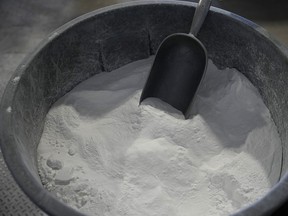Article content
Short bets worth billions of dollars against some of the world’s largest lithium producers are under threat as a supply glut shows signs of thinning.
UBS Group AG and Goldman Sachs Group Inc. have trimmed their 2024 supply estimates by 33 per cent and 26 per cent, respectively, while Morgan Stanley warned about the growing risk of lower inventories in China. The revisions come after lithium prices cratered last year as supply ran ahead of demand, with some producers cutting output.
Article content
Now, prices of the key material used to power electric vehicles are showing signs of a revival after the rout last year sent stocks spiralling and attracted short sellers. Bets against top producer Albemarle Corp. and Australian miner Pilbara Minerals Ltd. account for more than a fifth of their outstanding shares, or the equivalent of about US$5 billion, according to data compiled by Bloomberg.
Article content
“Double-digit capacity has already been taken out of the lithium market and that usually is a sign that the commodity price is bottoming,” said Jun Bei Liu, a hedge fund manager at Tribeca Investment Partners Pty Ltd. in Sydney, who holds a long position in Pilbara. Shorting the company “is very dangerous” given signals of support for the metal’s price.
Pilbara Minerals on Thursday said it accepted an offer for a lithium spodumene concentrate cargo ahead of a scheduled digital auction. This fills the company’s offtake book until December, the company said in a statement to the exchange. The contract “is an early sign of price improvement after the commodity’s recent plunge,” Bloomberg Intelligence analyst Mohsen Crofts said in a note.
Article content
Some short sellers may already have been caught after the two producers each climbed around 20 per cent in February. The Solactive global lithium index, which tracks the performance of 40 of the largest and most liquid lithium-related companies, jumped 10 per cent in the same period, swinging from an almost 20 per cent decline in January.
Investor bets against Pilbara Minerals are hovering around record levels at about 22 per cent of free float, equivalent to US$1.8 billion, making it the most shorted stock on Australia’s benchmark equity index, S&P Global data shows. Short interest for Albemarle stands at a similar proportion and represents US$3.2 billion in market value.
“We’re seeing improved sentiment so a lot of those short positions will need to be covered,” Ron Mitchell, managing director of Australian miner Global Lithium Resources Ltd., said.
Not everyone is convinced about the rebound, however. The surge in lithium contracts “should not be interpreted as the end of the bear market,” Goldman Sachs said in a note. The surplus remains sizable, it warned.
Article content
Still, other analysts expect prices to stabilize after those for lithium carbonate in China slid more than 80 per cent from record highs in 2022. Capital markets firm Canaccord Genuity Group Inc. in a note earlier this month said “sustainable” levels would soon return, while UBS doubts there will be further declines. The broker also said the market is re-balancing after some miners curtailed production.
Core Lithium Ltd. halted operations at its flagship lithium mine in January and is turning to uranium after a sharp rally in prices for the nuclear fuel. Meanwhile, Arcadium Lithium PLC said it will reduce output of spodumene, a mineral from which lithium is extracted.
“I suspect we are at or close to the bottom in lithium prices,” Matt Griffin, a fund manager at Maple-Brown Abbott Ltd. in Sydney, said. “The sign we are looking for to get bullish on the space is an increase in demand — either through EV demand surprising to the upside, or a restocking cycle in the battery supply chain.”
— With assistance from Annie Lee.
Bloomberg.com
Share this article in your social network




